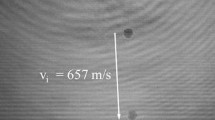Abstract
The particle–wall collision behavior plays a crucial role in determining particle motion during the simulation of multiphase flow processes. The coefficient of restitution (COR) is generally used to characterize the particle–wall collisional behavior. Correct consideration of COR is essential for obtaining accurate results in numerical simulations. In the present work, the COR during the normal impact of a rigid prolate ellipsoidal particle on the target wall is investigated using the finite element method. The loss in kinetic energy of the particles after impact is used to analyze the COR. The simulations are conducted with a particle of sphericity 1, 0.9, 0.8, 0.7, and 0.5 impacted at different orientation angles (angle between particle major axis to the horizontal plane) in the range 0°–90°. The effect of particle sphericity, particle orientation before impact, impact velocity, and target surface material on COR is determined. Further, an understanding is established on the deviation in COR for the impact of non-spherical particles as compared to the COR for the impact of spherical particles. The insights gained from this study are valuable for accurately predicting the motion of non-spherical particles in multiphase processes using the discrete element method.








Similar content being viewed by others
References
Tarodiya R, Levy A (2021) Surface erosion due to particle surface interactions—a review. Powder Technol 387:527–559
Johnson KL (1985) Contact mechanics. Cambridge University Press, Cambridge
Brach RM (1984) Friction, restitution, and energy loss in planar collisions. J Appl Mech 51:164–170
Thornton C (1997) Coefficient of restitution for collinear collisions of elastic perfectly plastic spheres. J Appl Mech 64:383–386
Li LY, Wu CY, Thornton C (2001) A theoretical model for the contact of elastoplastic bodies. Proc Inst Mech Eng Part C Mech Eng 216(4):421–431
Wu CY, Li LY, Thornton C (2003) Rebound behaviour of spheres for plastic impacts. Int J Impact Eng 28:929–946
Wu CY, Thornton C, Li LY (2009) A semi-analytical model for oblique impacts of elastoplastic spheres. Proc R Soc Lond A Math Phys Eng Sci 465(2103):937–960
Yu K, Tafti D (2016) Impact model for micrometer-sized sand particles. Powder Technol 294:11–21
Uzi A, Levy A (2018) Energy absorption by the particle and the surface during impact. Wear 404–405:92–110
Grant G, Tabakoff W (1975) Erosion prediction in turbomachinery resulting from environmental solid particles. J Aircraft 12:471–478
Forder A, Thew M, Harrison D (1998) A numerical investigation of solid particle erosion experienced within oilfield control valves. Wear 216:184–193
Yardeny I, Portnikov D, Kalman H (2020) Experimental investigation of the coefficient of restitution of particles colliding with surfaces in air and water. Adv Powder Tech 31:3747–3759
Cai L, Wang S, Li Y, Mao J, Li F, Liu Z, Gao J (2021) Experimental and numerical studies on rebound characteristics of non-spherical particles impacting on stainless-steel at high temperature. Powder Technol 381:110–121
Hastie DB (2013) Experimental measurement of the coefficient of restitution of irregular shaped particles impacting on horizontal surfaces. Chem Eng Sci 101:828–836
Wang J, Zhang M, Feng L, Yang H, Wu Y, Yue G (2020) The behaviors of particle-wall collision for non-spherical particles: experimental investigation. Powder Technol 363:187–194
Brosh T, Kalman H, Levy A (2014) DEM-CFD simulation of particle comminution in jet-mill. Powder Technol 257:104–112
Uzi A, Levy A (2018) Flow characteristics of coarse particles in horizontal hydraulic conveying. Powder Technol 326:302–321
Tarodiya R, Khullar S, Levy A (2022) Particulate flow and erosion modeling of a Pelton turbine injector using CFD-DEM simulations. Powder Technol 399:117168
Adesina P, O’Sullivan C, Wang T (2023) DEM study on the effect of particle shape on the shear behaviour of granular materials. Comput Part Mech. https://doi.org/10.1007/s40571-023-00632-8
de Arruda Tino AA, Tavares LM (2022) Simulating breakage tests using the discrete element method with polyhedral particles. Comput Part Mech 9:811–823
Lu G, Third JR, Müller CR (2012) Critical assessment of two approaches for evaluating contacts between super-quadric shaped particles in dem simulations. Chem Eng Sci 78:226–235
Rakotonirina AD, Wachs A (2018) Grains3D, a flexible DEM approach for particles of arbitrary convex shape—part II: parallel implementation and scalable performance. Powder Technol 324:18–35
Höhner D, Wirtz S, Scherer V (2015) A study on the influence of particle shape on the mechanical interactions of granular media in a hopper using the discrete element method. Powder Technol 278:286–305
Kiangi K, Potapov A, Moys M (2013) DEM validation of media shape effects on the load behaviour and power in a dry pilot mill. Miner Eng 46–47:52–59
Ben-Ami Y, Levy A (2016) Absorbed shear energy during solid particle impact on ductile surface. Wear 368–369:162–172
Johnson GR, Cook WH (1983) A constitutive model and data for metals subjected to large strains, high strain rates and high temperatures. Eng Fract Mech 21:541–548
Dahneke B (1975) Further measurements of the bouncing of small latex spheres. J Colloid Interface Sci 51:58–65
Wall S, John W, Wang H, Goren SL (1990) Measurements of kinetic energy loss for particles impacting surfaces. Aerosol Sci Technol 12(4):926–946
Author information
Authors and Affiliations
Corresponding author
Ethics declarations
Conflict of interest
The authors declare that they have no known competing financial interests or personal relationships that could have appeared to influence the work reported in this paper.
Additional information
Publisher's Note
Springer Nature remains neutral with regard to jurisdictional claims in published maps and institutional affiliations.
Rights and permissions
Springer Nature or its licensor (e.g. a society or other partner) holds exclusive rights to this article under a publishing agreement with the author(s) or other rightsholder(s); author self-archiving of the accepted manuscript version of this article is solely governed by the terms of such publishing agreement and applicable law.
About this article
Cite this article
Tarodiya, R., Levy, A. Numerical investigation of collision characteristics of non-spherical particles on ductile surfaces under normal impact. Comp. Part. Mech. (2024). https://doi.org/10.1007/s40571-024-00746-7
Received:
Revised:
Accepted:
Published:
DOI: https://doi.org/10.1007/s40571-024-00746-7




